Grapevine Lattice
By Dr. Larry Keig
Grapevine Lattice is an easily identified pattern made up entirely or largely of highly embossed interlocking gnarled vines. The crisscrossing creates the illusion of diamonds within divisions.
The pattern is found on the exterior of pitchers, tumblers and hats. It is located on the inner surface of bowls and plates. On all shapes, the opposite surface is unpatterned. Other design elements are part of the patterning of the water set pieces and hats.
The pattern was produced by both Dugan and Diamond. The design first appeared in extant industry catalogs in spring 1912. Its shelf life was long as items in the pattern continued to appear in advertising materials into the 1920s.
Pitchers and Tumblers
The pitcher is the preeminent item in the pattern. However, items in other shapes are highly desirable when the iridescence is of superior quality.
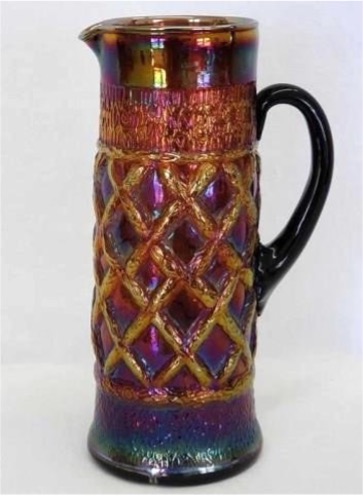
Pitchers. The seven and one-fourth inch lattice band on the tankard pitcher extends from the lowest level of the handle’s fold to about two and three-fourth inches from the vessel’s base. Above the latticework are two other bands. The band just above the lattice, separated by a narrow cord, resembles knotted tree bark. The one and one-fourth inch band at the top is unpatterned. The two and one-half inch band below the dominant design extends to near the protruding base. It is an indistinct pattern, apparently designed as filigree to fill space.
In all, the pitcher stands eleven and one-half inches tall. Its top diameter is four inches, four and three- fourth inches from tip of spout to its opposite side. The recessed base measures four and three-fourth inches from edge to edge. The underside of the base is pattern plain.
Pitchers, tumblers, and water sets are available in marigold, purple/ amethyst, cobalt, and white. While the base color of the amethyst, the commonest color, and blue, the hardest to find, are practically identical from example to example, the surface color and iridescence on these and the other colors, vary widely. Color is lush on some pitchers but light and washed out on others. On occasion, the surface color is different—good or bad–from one element of the pattern to another. Their handles—clear crystal on the marigold and white, purple and deep blue on the dark items—are non-iridized.
The spectacularly shimmering pitcher pictured sold at the 2018 ICGA convention auction. It had once been in, as Jim and Jan Seeck noted in the listing, Woody Funk’s fabled collection.
Tumblers
Tumblers are four inches tall. Their top diameters are three inches, give or take about a quarter of an inch in either direction. Their recessed bases range from two and one-fourth to two and three-eighth inches across.
Like pitchers, tumblers are available in marigold, amethyst/purple, cobalt blue, and white. The marigold and amethyst are easy to find. The white is harder to track down but available. The cobalt rarely surface. The quality of surface colors of the marigold, amethyst, and white vary widely. Iridescence on some is beautiful, on others borderline or worse. The surface color of the cobalt is often largely or partially a gun metal silver or a dull gold.
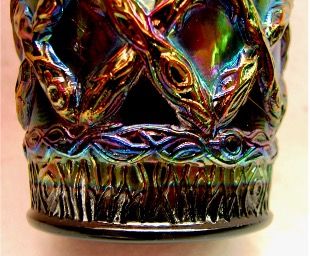
The standard tumbler has the grass around the bottom.
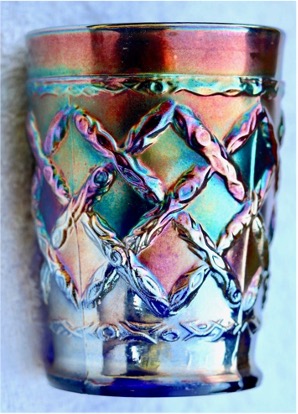
The variant tumbler lacks the grass.
Unlike pitchers, all of which are alike in design, tumblers come in two versions. The standard version has three pattern elements. The primary element is the lattice. The second is a narrow cord that demarcates the latticework from “switch grass” which fills the area between it and the base. An area at the top is un-patterned. The amethyst are occasionally found with souvenir lettering wrapped around this plain band. Most, maybe all, the marigold, amethyst, and white tumblers are the standard version. The illustrated slice of Neal Becker’s amethyst tumbler shows the lattice work, the cord, and the grass at the bottom.
The other version, a variant, is the same as the standard except that there is no grass beneath the cord. All blue tumblers appear to be the variant. Diane Highnam’s photo is of the “grassless” cobalt variant.
Water sets are available in all colors. It is difficult to find water sets in which the surface color of all items are well matched.
Hats
Hats are derivatives of tumblers and available in the same base or surface colors except that cobalt has yet to be reported. While most colors and shapes are not thought of as rare, none are seen all that often. They have base diameters of two and one-fourth or so inches, noteworthy because it helps distinguish them from hats in another Dugan/Diamond pattern.
JIPS. Nearly all hats are jack-in-the-pulpit in shape. At the apex, they range from three and one-half to four inches in height. At the lowest point, they measure from just under two inches to slightly over that. The taller examples look more graceful than the scrunched down versions.
The white surface most often. Some of these are souvenirs, with hand-written black lettering of U.S. and Canadian towns and hamlets crudely scrawled or artfully penned at the broadest area of the interior. The next most available is the marigold. No amethyst JIP is listed as having sold in the HOC database but Dave Doty has noted that one sold on eBay in 2002*, so others are surely in circulation. In the JIP, it’s the color that is most eagerly sought by hat collectors.
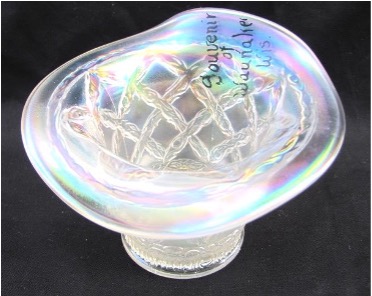
The white hat pictured, from the HOC site, reads “Souvenir of Waunakee, Wis.” Waunakee, Native American for “fair and pleasant valley,”, is a community currently of around 12,000 not far from Madison. The surface of the souvenir is frosty, its iridescence a multicolor pastel, and its lettering legible and clean.
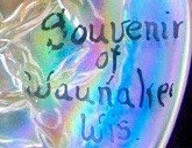
The small photo, above, shows the souvenir writing from the white hat to the left.
Tri-Corner. The inspiration for this article came from the surfacing of a tri-corner hat. In amethyst, it is the only Grapevine Lattice hat in this shape for which there is a record**. It measures about six inches across when propped up in its most attractive position. It stands just over three inches tall from base to upper rim. Because the base color is light, an almost transparent lavender, the pattern can be seen through the plain interior.
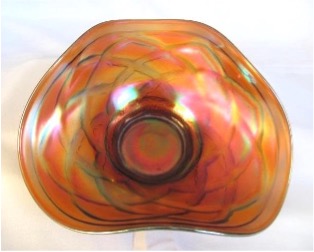
Galen and Kathi Johnson found it in August 2014 at The Rooster, a well-known antique shop in downtown Rochester, Minnesota. They bought it because it looked unusual. It is. It remained in their collection until it was sold by the Burns Auction Service in 2016 to Dick and Barbara Thorne. Two years later Dick listed it on eBay where it changed hands again via a “Make an Offer” transaction.
Sidebar. Grapevine Lattice hats are sometimes misidentified as the version of Lattice and Points with plain interior, the pattern Marion Hartung called Vining Twigs (Book Seven, p. 74). The surest way to determine which is which is to know their base diameters. That of Grapevine Lattice is two and three-eighth or slightly less. Lattice and Points measure about two and three-fourth inches.
Moreover, Lattice and Points hats are usually, if not always, ruffled, a shape that has yet to be reported in Grapevine Lattice.
Bowls and Plates
Grapevine Lattice bowls and plates are medium- sized. Both shapes were formed from the same mold.
Bowls. All reported bowls are six- and eight- low- ruffled. They range in size from six and three-eighth to well over seven inches in diameter and stand about one and one-half inches tall, give or take an eighth of an inch either way. It is surprising they are seemingly unavailable in a wider range of shapes, e.g., deep ruffled, ice cream, and proof.
They are available in a limited range of colors: marigold, purple/amethyst, and white. By far the commonest color is white. The marigold and amethyst are scarce and more difficult to find than the plates, an unusual circumstance in the world of carnival.
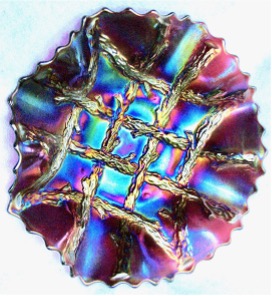
The illustrated purple, with great bright iridescence, is Neal Becker’s. Its top diameter is seven and five-eighth inches. It is one and three-fourth inches tall.
Plates. The top diameter of plates ranges from six and three- fourth to seven and seven-eighth inches. Normally the greater the diameter, the flatter they are.
The marigold and amethyst are seen most often. The white are more difficult to find. The peach opal hardly ever surface. The iridescence is variable on the marigold, amethyst, and white, ranging from lush or bright to light or dull. The surface color and iridescence on the few reported peach opal are anemic.
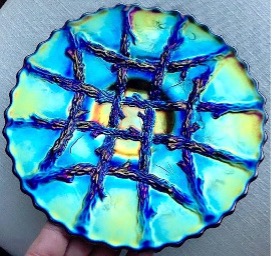
The illustrated seven and one- half inch plate is a vivid amethyst. It sold in March 2018 on a Wroda auction for which Jim and Laurie’s listing indicated that “each twig is electric purple and each window is bright radium gold.” Their photo has been lifted from the HOC site.
Some plates are souvenirs, with enameled lettering wedged within divisions around the outer edge. One amethyst, with white lettering, is inscribed “Souvenir of Belle Plaine, Ia”. This small town is located about 35 miles west of Cedar Rapids and 70 miles east of Des Moines. It was a point on the old Lincoln Highway, an early trans- continental route that extended from New York City to San Francisco, and is still on the Overland Route of the cross-country Union PacificRailroad line. Another amethyst reads “Souvenir of “Slady Fork, W.Va.” This now unincorporated community is in the south- eastern part of the state.
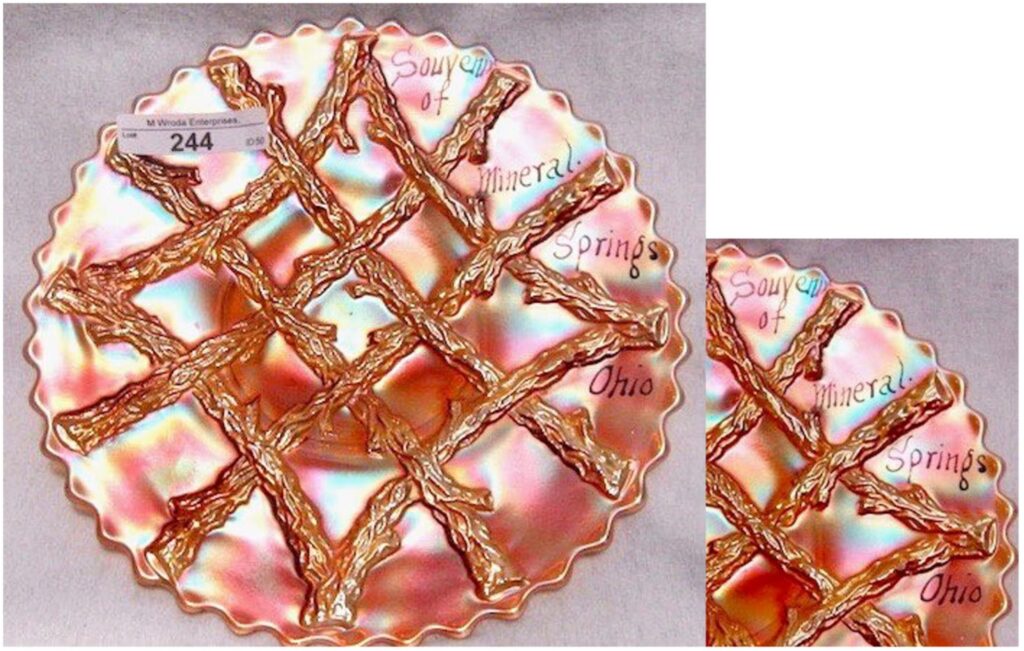
A marigold plate, lettered in black, is a commemorative of Mineral Springs, Ohio, an unincorporated village 75 miles south of Columbus***. Illustrated here, it has nice color and good souvenir penmanship, the script within four contiguous divisions around the outer edge. It sold on a Wroda auction in October 2018.
Notes
*I recall seeing the listing for this hat. If my memory correctly serves me, the listing photo was of poor quality and the iridescence appeared marginal at best.
**A single tri-corner Grapevine Lattice hat is currently known but there must be others. I ask that readers report them.
***I would like to be informed of other Grapevine Lattice pieces with souvenir lettering.
This article first appeared in the ICGA Pump in the September 2020 issue and is reprinted with permission.
